Understanding Conventional Mortgage Loans: Advantages and Needs
Understanding Conventional Mortgage Loans: Advantages and Needs
Blog Article
The Vital Factors to Take Into Consideration When Deciding On In Between Fixed-Rate and Variable-rate Mortgage Lendings
When evaluating home loan alternatives, consumers face a pivotal choice in between adjustable-rate and fixed-rate loans, each presenting potential pitfalls and distinctive benefits. Key considerations such as passion price stability, predictability in month-to-month repayments, and the implications of potential rate adjustments can significantly influence long-term monetary wellness.
Passion Rate Stability
When choosing a mortgage, recognizing rates of interest stability is crucial for notified decision-making. Rate of interest can dramatically influence the general price of a home loan, and identifying the nature of these rates is vital for debtors. Fixed-rate home mortgages use the benefit of consistent month-to-month settlements over the life of the lending, protecting debtors from market changes. This stability makes it possible for house owners to prepare their finances with greater assurance, as they will not be influenced by increasing rates of interest.
On the other hand, adjustable-rate home mortgages (ARMs) start with reduced initial prices that may transform periodically based upon market problems. While this can lead to reduced repayments originally, it also presents unpredictability, as debtors may face boosted payments if rates of interest climb. For those considering an ARM, it is important to examine the possibility of price changes, the possibility for repayment increases, and the size of the initial fixed-rate period.
Ultimately, the option in between adjustable-rate and fixed-rate home mortgages hinges on individual threat resistance and financial conditions. Recognizing rate of interest stability assists borrowers make educated decisions that align with their lasting financial goals.
Regular Monthly Repayment Predictability
While customers usually focus on passion price stability, the predictability of regular monthly repayments is just as vital in the mortgage selection process (Conventional mortgage loans). Regular monthly settlement predictability plays a critical function in budgeting and monetary planning, as it directly influences a home owner's cash money circulation and general financial wellness
Fixed-rate home loans offer a constant month-to-month payment throughout the life of the finance, allowing customers to prepare for and intend their expenditures properly. This security can be especially beneficial for newbie buyers or those on a set income, as it gets rid of the unpredictability related to rising and fall repayments.
On the other hand, variable-rate mortgages (ARMs) typically feature reduced initial settlements that can change with time, leading to possible variability in monthly commitments. While initially attractive, this changability can make complex financial planning, specifically if customers do not account for future rate adjustments.
Potential Price Adjustments
In the world of adjustable-rate home mortgages (ARMs), possible rate modifications stand for a substantial factor that customers need to very carefully consider. Unlike fixed-rate home mortgages, where the rate of interest stays unchanged for the life of the lending, ARMs are identified by fluctuating rate of interest that are connected to market indices. This variability can result in considerable adjustments in regular monthly payments, impacting the customer's monetary planning and budgeting.
Typically, ARMs have a first fixed-rate period during which the interest price is secure. After this duration, nevertheless, the rate changes at fixed intervals-- frequently annually. Borrowers need to be mindful of the margin and index made use of to compute these adjustments, as they directly influence future passion prices. In addition, ARMs typically consist of caps that restrict exactly how much the rate of interest can enhance at each change and over the life of the car loan, which can supply some level of defense versus extreme rate walks.
Understanding these possible adjustments is crucial for debtors, as they straight influence long-term payment commitments. Assessing personal financial scenarios and risk resistance is vital when making a decision whether an ARM straightens with one's financial goals.
Funding Term Considerations
Loan term factors to consider play a critical function in the decision-making procedure for debtors selecting in between fixed-rate and adjustable-rate home mortgages. The length of the lending term substantially influences month-to-month repayments, passion prices, and general financial planning.

Inevitably, customers must assess their individual conditions, financial objectives, and web link market problems when weighing the implications of loan term selections within each mortgage kind.

Overall Cost of Borrowing
The total price of loaning is a critical variable that can considerably influence a borrower's selection between adjustable-rate and fixed-rate mortgages. Fixed-rate home loans offer foreseeable monthly settlements, as the rate of interest stays consistent throughout the finance term. This predictability can result in reduced overall expenses, specifically in a stable or declining passion price environment. Debtors can spending plan effectively, understanding their settlements will not vary.
On the other hand, variable-rate mortgages (ARMs) typically start with lower preliminary prices, causing lowered ahead of time prices. These prices can boost after an initial period, leading to possibly greater long-term expenses. Customers must consider the frequency and extent of rate modifications, in addition to the general finance period, to properly assess the monetary ramifications.
Furthermore, the overall cost of borrowing includes not only rate of like it interest but additionally costs and various other linked expenses, such as closing costs and insurance policy (Conventional mortgage loans). As a result, when evaluating mortgage options, consumers must carry out a complete expense analysis over the life of the lending. By doing so, they can make an informed choice that aligns with their economic goals and take the chance read this article of tolerance
Verdict
Finally, selecting in between fixed-rate and adjustable-rate home loan requires mindful consideration of numerous crucial variables. Rates of interest security and month-to-month payment predictability are extremely important for effective budgeting, while the potential for price changes in ARMs introduces economic uncertainty. Additionally, the anticipated duration of homeownership and the total cost of borrowing, consisting of rate of interest and associated charges, need to align with individual economic circumstances and run the risk of resistance. Such a comprehensive evaluation will promote informed decision-making in home mortgage choice.
Secret factors to consider such as passion rate stability, predictability in monthly payments, and the effects of possible price modifications can significantly impact long-lasting monetary health and wellness. Rate of interest rates can considerably influence the total price of a home mortgage, and identifying the nature of these prices is necessary for borrowers. Unlike fixed-rate mortgages, where the interest price stays the same for the life of the funding, ARMs are identified by changing rate of interest rates that are linked to market indices. In addition, ARMs frequently include caps that limit just how a lot the interest price can raise at each change and over the life of the finance, which can supply some level of defense against radical rate hikes.
Passion rate security and monthly settlement predictability are extremely important for efficient budgeting, while the potential for price modifications in ARMs introduces economic uncertainty.
Report this page